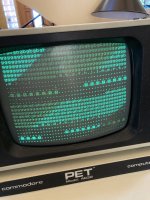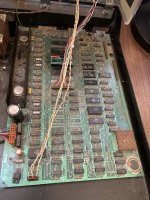irataxy
Member
Hello,
I recently fixed the power problems with my PET 4032 but noticed that the display would not come on. The computer would also chime on startup. I bought a ROMulator with PETTEST ROM to help diagnose the issue. On startup, this is what I see now. In looking at the manual, I think this indicates errors on pages 0 and 1 of the RAM. Is this correct? If so, should I look at replacing some chips on the board? What is the next step for me here?
Thanks,
NIck

I recently fixed the power problems with my PET 4032 but noticed that the display would not come on. The computer would also chime on startup. I bought a ROMulator with PETTEST ROM to help diagnose the issue. On startup, this is what I see now. In looking at the manual, I think this indicates errors on pages 0 and 1 of the RAM. Is this correct? If so, should I look at replacing some chips on the board? What is the next step for me here?
Thanks,
NIck


